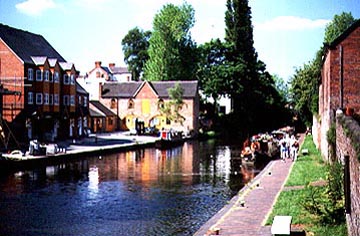|
The Stour is a tributary of the Severn. Its source is near Halesowen. The total river length is about 30 kilometres (20 miles) to its junction with the Severn at Stourport. Places on the Stour
StourbridgeThe town grew up as a crossing point of the River Stour. Its first growth came when it began to manufacture firebricks for furnaces using local clay. In 1550, refugee Hungarians settled here and began to make fine glass. It continued to grow during the Industrial Revolution due to its location close to coal mines.
KidderminsterKidderminster straddles the River Stour. The town is mentioned in the Domesday Book, and cloth was manufactured as early as the 14th century, obtaining a high reputation throughout the Middle Ages. The skills in the town were the reason why, from about 1730 (the early Industrial Revolution) the town expanded as a major center for the manufacture of carpets. It was said that the main advantage of Kidderminster was also that the dyes were long lasting due to the quality of the Stour water, which contained fuller's earth and iron. Spinning and dyeing were other important industries. The Staffordshire and Worcester canal linked Kidderminster with Birmingham with the Severn at Stourport. Until the 1960s the view across the town was still dominated by the mill chimneys of the carpet makers. All these have now been virtually demolished.
StourportStourport is not an ancient center but owes its existence to the opening of the Stafford and Worcester canal in 1780. It quickly developed a canal-based trade and also began to manufacture carpets and iron ware.

Stourport is a canal port where the Stour joins the Severn. Its canal basin was once an important industrial center but now it is busy as a marina for canal leisure craft.
|